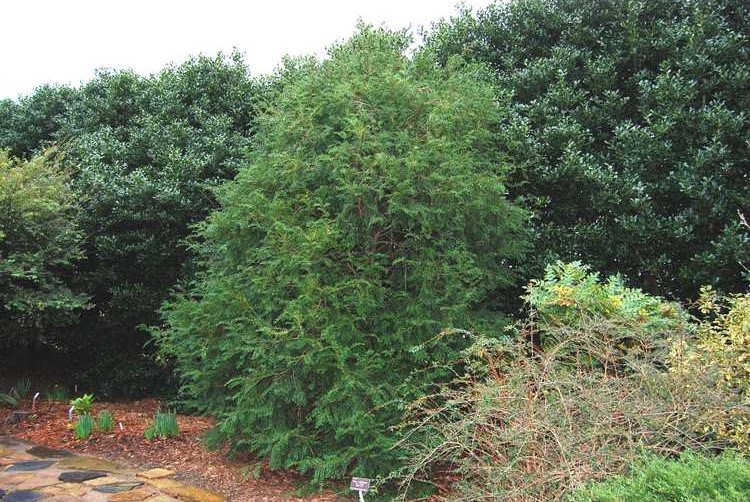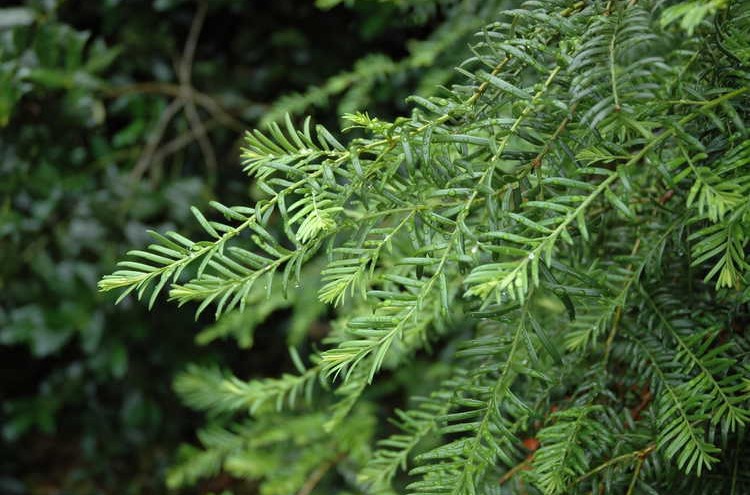Taxus mairei, as described in 1960 by (Lemée & H. Lév.) Shiu Ying Hu in Illustrations of Native and Introduced Ligneous Plants of Taiwan, 1st edition; is commonly known as Maire's yew, as well as Š°ç£ç´…è±†æ‰ (nanfang hongdoushan) in the Chinese language. The species name honors French missionary and plant collector Edouard-Ernest Maire (1848 - 1932), who collected the type specimen near Dongchuan Shi in NE Yunnan.
Various authors have treated T. mairei as synonymous with, or a variety of, T. chinensis, T. sumatrana, and T. wallichiana. Note that T. mairei was described prior to T. chinensis, thus treatment within that taxon is incorrect. Regardless, as noted in the Taxus discussion, analysis using both morphological and molecular data has confirmed that the Chinese taxa are sufficiently distinct to warrant treatment at species rank, despite some evidence of past natural hybridization between T. chinensis, T. mairei and T. wallichiana.
Description. Maire's yew is an evergreen, coniferous species of shrub or small tree that grows to mature heights of 100 feet (30 m) tall, with a normally single trunk up to 60 inches (150 cm) in diameter, measured at breast height.
- A tree's crown is pyramidal, rounded or spreading.
- Bark is thin and variable, colored red, purple, brown or gray, exfoliating in strips or flakes.
- Twigs grow alternating along the branches. They are slender, round in cross-section, and finely grooved along decurrent leaf bases. Shoots are green at first, later turning orange- or purple-brown.
- Leaves are held in ranks of 2, spreading at nearly right angles to the shoot. Individual needles measure 0.6 to 1.4 inches (15 - 35 mm) long and 0.08 to 0.16 inch (2 - 4 mm) broad; and are linear, usually falcate shaped, thick, arnd coriaceous, with revolute margins, and a cuspidate to mucronate apex. Midribs on upper sides are raised in a shallow groove 0.008 to 0.012 inch (0.2 - 0.3 mm) wide, continuous to apex. Midrib on lower side is flat with few or no papillae, continuous to apex. Needles are colored dark green above with two pale yellow stomatal bands below.
- Pollen cones appear axillary in rows on either side of fertile shoots. They have an ovoid shape, measure 0.2 to 0.32 inch (5 - 6 mm) long and 0.12 to 0.16 inch (3 - 4 mm) wide, colored yellow-green to pale brown, each with 8 to 14 microsporophylls.
- Seed cones appear axillary, solitary or in pairs, on the lower side of shoots, with an aril that is green at first and covering lower half of seed, later swelling to orange or red and covering seed which measures 0.4 to 0.52 inch (10 - 13 mm) long and 0.28 to 0.4 inch (7 - 10 mm) wide.
Distribution. This species is native to Taiwan and China. In Taiwan, it is found in northern and central parts of the island growig at elevations of 3,300 to 10,000 feet (1,000 - 3,000 m) above sea level. According to Aljos Farjon, the distribution in China is unclear. Farjon (2010) finds it in Anhui, Fujian, southern Gansu, northern Guangdong, northern Guangxi, Guizhou, western Henan, western Hubei, Hunan, Jiangsu, Jiangxi, southern Shaanxi, Sichian, Yunnan, and Zhejiang provinces, but Zhang and Ru (2010) say it is confined to Guangxi, Hubei, Shanxi, Sichuan and Yunnan, with natural forests dominated by this species limited to Guangxi and southeastern Shanxi. It is found from near sea level to 11,500 feet (3,500 m) elevation within conifer and mixed forests and on more open slopes; also on rocky slopes, often on limestone; often riparian.

